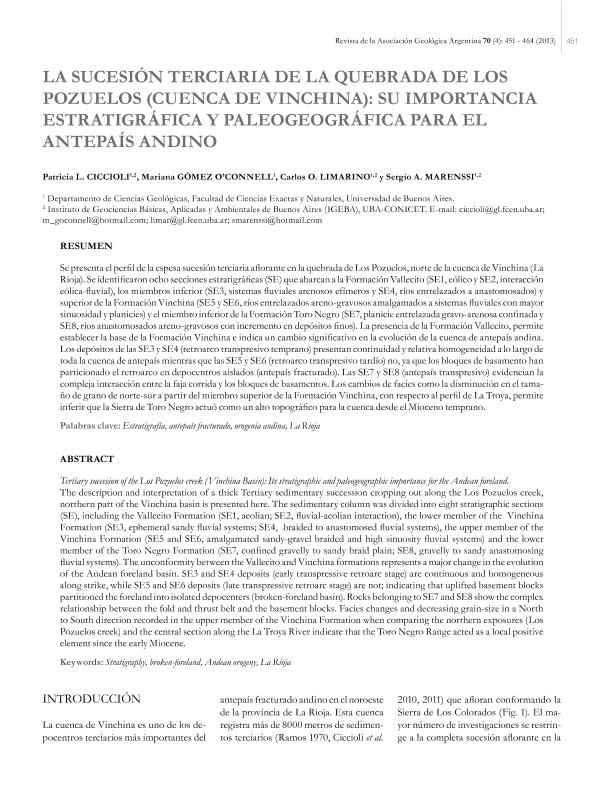Artículo
Se presenta el perfil de la espesa sucesión terciaria aflorante en la quebrada de Los Pozuelos, norte de la cuenca de Vinchina (La Rioja). Se identificaron ocho secciones estratigráficas (SE) que abarcan a la Formación Vallecito (SE1, eólico y SE2, interacción eólica-fluvial), los miembros inferior (SE3, sistemas fluviales arenosos efímeros y SE4, ríos entrelazados a anastomosados) y superior de la Formación Vinchina (SE5 y SE6, ríos entrelazados areno-gravosos amalgamados a sistemas fluviales con mayor sinuosidad y planicies) y el miembro inferior de la Formación Toro Negro (SE7, planicie entrelazada gravo-arenosa confinada y SE8, ríos anastomosados areno-gravosos con incremento en depósitos finos). La presencia de la Formación Vallecito, permite establecer la base de la Formación Vinchina e indica un cambio significativo en la evolución de la cuenca de antepaís andina. Los depósitos de las SE3 y SE4 (retroarco transpresivo temprano) presentan continuidad y relativa homogeneidad a lo largo de toda la cuenca de antepaís mientras que las SE5 y SE6 (retroarco transpresivo tardío) no, ya que los bloques de basamento han particionado el retroarco en depocentros aislados (antepaís fracturado). Las SE7 y SE8 (antepaís transpresivo) evidencian la compleja interacción entre la faja corrida y los bloques de basamentos. Los cambios de facies como la disminución en el tamaño de grano de norte-sur a partir del miembro superior de la Formación Vinchina, con respecto al perfil de La Troya, permite inferir que la Sierra de Toro Negro actuó como un alto topográfico para la cuenca desde el Mioceno temprano. The description and interpretation of a thick Tertiary sedimentary succession cropping out along the Los Pozuelos creek, northern part of the Vinchina basin is presented here. The sedimentary column was divided into eight stratigraphic sections (SE), including the Vallecito Formation (SE1, aeolian; SE2, fluvial-aeolian interaction), the lower member of the Vinchina Formation (SE3, ephemeral sandy fluvial systems; SE4, braided to anastomosed fluvial systems), the upper member of the Vinchina Formation (SE5 and SE6, amalgamated sandy-gravel braided and high sinuosity fluvial systems) and the lower member of the Toro Negro Formation (SE7, confined gravelly to sandy braid plain; SE8, gravelly to sandy anastomosing fluvial systems). The unconformity between the Vallecito and Vinchina formations represents a major change in the evolution of the Andean foreland basin. SE3 and SE4 deposits (early transpressive retroarc stage) are continuous and homogeneous along strike, while SE5 and SE6 deposits (late transpressive retroarc stage) are not; indicating that uplifted basement blocks partitioned the foreland into isolated depocenters (broken-foreland basin). Rocks belonging to SE7 and SE8 show the complex relationship between the fold and thrust belt and the basement blocks. Facies changes and decreasing grain-size in a North to South direction recorded in the upper member of the Vinchina Formation when comparing the northern exposures (Los Pozuelos creek) and the central section along the La Troya River indicate that the Toro Negro Range acted as a local positive element since the early Miocene.
La sucesión terciaria de la quebrada de Los Pozuelos (cuenca de Vinchina): su importancia estratigráfica y paleogeográfica para el antepaís andino
Título:
Tertiary succesion of the Los Pozuelos creek (Vinchina Basin): Its stratigraphic and paleogeographic importance for the Andean foreland
Ciccioli, Patricia Lucia ; Gómez O Connell, Mariana; Limarino, Carlos Oscar
; Gómez O Connell, Mariana; Limarino, Carlos Oscar ; Marenssi, Sergio Alfredo
; Marenssi, Sergio Alfredo
 ; Gómez O Connell, Mariana; Limarino, Carlos Oscar
; Gómez O Connell, Mariana; Limarino, Carlos Oscar ; Marenssi, Sergio Alfredo
; Marenssi, Sergio Alfredo
Fecha de publicación:
12/2013
Editorial:
Asociación Geológica Argentina
Revista:
Revista de la Asociación Geológica Argentina
ISSN:
0004-4822
e-ISSN:
1851-8249
Idioma:
Español
Tipo de recurso:
Artículo publicado
Clasificación temática:
Resumen
Palabras clave:
Estratigrafía
,
Antepaís Fracturado
,
Orogenia Andina
,
La Rioja
Archivos asociados
Licencia
Identificadores
Colecciones
Articulos(IGEBA)
Articulos de INSTITUTO DE GEOCIENCIAS BASICAS, APLICADAS Y AMBIENTALES DE BS. AS
Articulos de INSTITUTO DE GEOCIENCIAS BASICAS, APLICADAS Y AMBIENTALES DE BS. AS
Articulos(SEDE CENTRAL)
Articulos de SEDE CENTRAL
Articulos de SEDE CENTRAL
Citación
Ciccioli, Patricia Lucia; Gómez O Connell, Mariana; Limarino, Carlos Oscar; Marenssi, Sergio Alfredo; La sucesión terciaria de la quebrada de Los Pozuelos (cuenca de Vinchina): su importancia estratigráfica y paleogeográfica para el antepaís andino; Asociación Geológica Argentina; Revista de la Asociación Geológica Argentina; 70; 4; 12-2013; 451-464
Compartir



